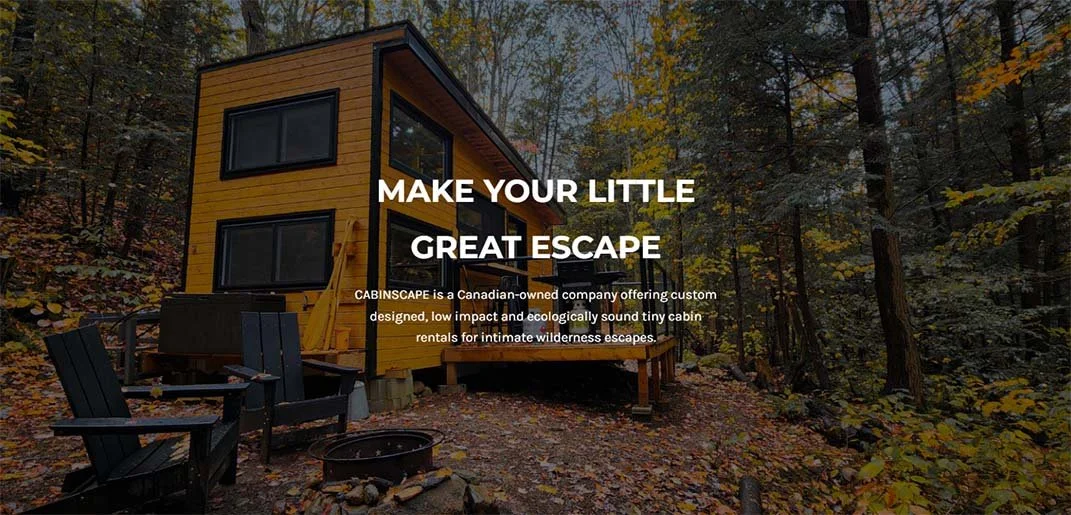A successful off-grid cabin business — Cabinscape
A case study on creating a vacation rental business with tiny homes or cabins
Case Study 02: Capinscape
Overview
Cabinscape, a Canadian-owned company, has carved out a strong niche in the eco-tourism market in an unexpected way. They do this by offering off-grid, low-impact tiny cabin rentals across Ontario. Their mission is rooted in creating immersive wilderness escapes while emphasizing environmental sustainability. Founded by Laura Mendes and John Stoneman, the business has grown from a passion project to a recognized player in the nature tourism sector. Cabinscape provides unique, remote cabin experiences that cater to adventure-seekers, nature enthusiasts, and eco-conscious travelers.
Key Success Factors and Strategies
1. Sustainable and Off-Grid Design Cabinscape's cabins are characterized by their sustainable and minimalistic design, featuring composting toilets, solar power systems, and water-saving solutions. This focus on sustainability resonates strongly with their target market and ensures lower operational costs by minimizing dependency on traditional infrastructure. This commitment to green practices aligns well with the growing demand for environmentally responsible tourism options.
2. Carefully Curated Locations The company’s approach to site selection has been a critical element of its success. Cabins are strategically placed in remote but scenic locations across Ontario. They are often close to hiking trails, lakes, and conservation areas. This proximity to natural attractions provides guests with a unique opportunity to unplug and immerse themselves in nature.
3. Target Market and Market Fit Cabinscape's primary customers include urban professionals and young couples seeking a break from city life, as well as eco-tourists and adventure travelers. The brand capitalized on the rising interest in "staycations" during the COVID-19 pandemic, when domestic travel became more appealing. The cabins offer a blend of rustic charm and essential modern amenities, positioning Cabinscape as an attractive option for short-term getaways.
4. Direct and Streamlined Booking Experience The company places emphasis on direct bookings through its website, thereby retaining customer control and reducing reliance on external booking channels. Cabinscape offers an intuitive online booking system that allows customers to filter cabins by remoteness (low, medium, high) to suit their comfort level and desired experience.
5. Lean Expansion Model Starting with a few units in select locations, Cabinscape has taken a cautious, lean approach to expansion. By gauging interest and gradually increasing the number of cabins, they have managed to grow without overextending themselves financially. This flexible strategy enables them to quickly adapt to market demands and maintain profitability while keeping risks manageable. The mobile design of many of their cabins lends itself to this flexible nature.
Cabinscape Design
Simple, Rustic, Thoughtful
3 Sizes
Cabinscape has multiple cabin styles for meeting local standards and investors budgets.
Financials and Revenue Model
Cabinscape revenue model is based on nightly cabin rentals priced between CAD 179 to CAD 199, depending on cabin type and location. Based on an occupancy rate of 50%, which is typical for an entire year, Cabinscape would have around $2700 per month in rental income per space, which would net $32,400 per year. The streamlined nature of their operations, low-impact designs, and emphasis on direct bookings contribute to a lean and profitable business model. Given the minimized running costs a significant margin of the rental earnings should be left for them as profit, $1500-$1800 would be expected.
Marketing and Brand Building
Cabinscape has successfully utilized social media platforms, in particular Instagram, where they currently have 114,700+ followers. They have used this platform to build a strong brand identity around scenic, eco-friendly escapes. By featuring guest-generated content and collaborating with influencers, they have expanded their reach and fostered organic growth. Their marketing highlights the serene beauty of their remote cabins, enticing potential guests with promises of rejuvenation, solitude, and natural beauty.
Operational Efficiencies and Challenges
Cabinscape relies heavily on technology for managing guest experiences. Self-check-in processes and digital guides enable the company to operate with minimal staff while maintaining a high level of customer satisfaction. However, their remote locations present operational challenges such as consistent maintenance and turnover services. They mitigate these challenges by forming local partnerships for cleaning and maintenance, ensuring smooth operations without inflating costs.
Lessons for Aspiring Tiny Home Resort Operators
1. Emphasize a Unique Value Proposition: Cabinscape’s success demonstrates the importance of a strong brand identity and differentiated offerings. For potential competitors or those looking to emulate their model, focusing on niche markets, such as eco-tourism or immersive nature stays, can help attract loyal customers.
2. Maintain Flexibility and Adaptability: Starting small and expanding based on market demand allowed Cabinscape to minimize risk while testing different locations and concepts. Gradual scaling helps ensure financial sustainability and allows for quick pivots if market conditions change.
3. Focus on Sustainability: Modern travelers are increasingly drawn to brands that prioritize environmental responsibility. Building eco-friendly, off-grid homes not only lowers costs but also aligns with consumer preferences.
4. Leverage Technology: Streamlining bookings, customer management, and self-check-in processes minimizes operational costs and enhances customer satisfaction. These aspects are critical to operating remote destinations efficiently.
5. Cultivate Community and Customer Loyalty: By engaging with customers on social media and leveraging user-generated content, Cabinscape has turned satisfied guests into brand ambassadors, enhancing their market reach without excessive marketing spend.
This case study of Cabinscape showcases how a thoughtful approach to market positioning, sustainable practices, and strategic growth can lead to success in the tourism sector. Do you find these insights valuable to your journey as an entrepreneur or investor? Maybe you already know these lessons - then now is the time to implement!
Feel welcome to visit Cabinscape for yourself at cabinscape.com.


